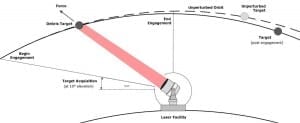Creon Levit Introduces LightForce from paul hugel on Vimeo.
LightForce Principle Concepts
James Mason, Jan Stupl, William Marshall, Creon Levit
(Submitted on 9 Mar 2011 (v1), last revised 19 Jul 2011 (this version, v3))
We focus on preventing collisions between debris and debris, for which there is no current, effective mitigation strategy. We investigate the feasibility of using a medium-powered (5 kW) ground-based laser combined with a ground-based telescope to prevent collisions between debris objects in low-Earth orbit (LEO). The scheme utilizes photon pressure alone as a means to perturb the orbit of a debris object. Applied over multiple engagements, this alters the debris orbit sufficiently to reduce the risk of an upcoming conjunction. We employ standard assumptions for atmospheric conditions and the resulting beam propagation. Using case studies designed to represent the properties (e.g. area and mass) of the current debris population, we show that one could significantly reduce the risk of nearly half of all catastrophic collisions involving debris using only one such laser/telescope facility. We speculate on whether this could mitigate the debris fragmentation rate such that it falls below the natural debris re-entry rate due to atmospheric drag, and thus whether continuous long-term operation could entirely mitigate the Kessler syndrome in LEO, without need for relatively expensive active debris removal.
Keywords: Space debris, collision avoidance, conjunction analysis, Kessler syndrome, active debris removal, laser
download PDF Orbital Debris-Debris Collision Avoidance
download PDF Satellite Laser Communications on the Cheap
